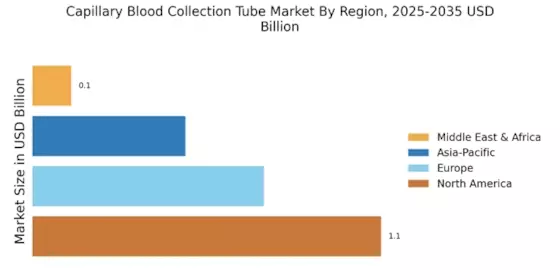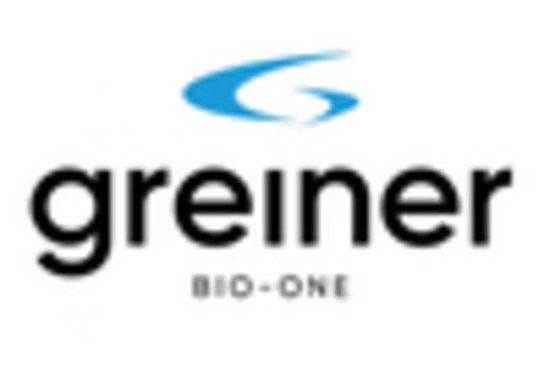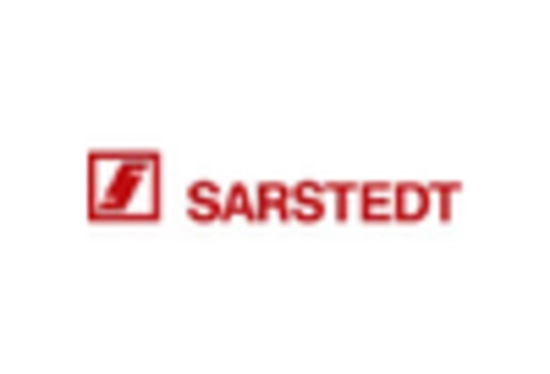Shift Towards Home Healthcare Solutions
The Capillary Blood Collection Tube Market is witnessing a shift towards home healthcare solutions, driven by the increasing preference for at-home medical services. Patients are increasingly seeking convenience and flexibility in managing their health, leading to a rise in home-based blood collection methods. This trend is supported by advancements in telemedicine and remote patient monitoring technologies, which facilitate the collection and analysis of blood samples in non-clinical settings. Market analysis indicates that the home healthcare segment is projected to grow at a rate of 9% over the next few years, highlighting the potential for capillary blood collection tubes to play a crucial role in this evolving landscape. As healthcare providers adapt to these changes, the Capillary Blood Collection Tube Market is likely to expand in response.
Increasing Prevalence of Chronic Diseases
The Capillary Blood Collection Tube Market is significantly influenced by the rising prevalence of chronic diseases, such as diabetes and cardiovascular conditions. As these diseases become more common, the need for regular blood monitoring and testing escalates. This trend is particularly evident in regions where healthcare systems are adapting to manage chronic conditions more effectively. Data suggests that the number of individuals requiring routine blood tests is expected to increase by approximately 5% annually, thereby propelling the demand for capillary blood collection tubes. The ability of these tubes to facilitate quick and efficient blood sampling aligns well with the growing healthcare focus on early diagnosis and continuous monitoring, further bolstering the Capillary Blood Collection Tube Market.
Technological Innovations in Blood Collection
Technological advancements play a pivotal role in shaping the Capillary Blood Collection Tube Market. Innovations such as improved tube materials, enhanced safety features, and automated collection systems are emerging trends that enhance the efficiency and reliability of blood sampling. For instance, the introduction of tubes with integrated safety mechanisms has been shown to reduce the risk of needle-stick injuries, thereby increasing their appeal among healthcare professionals. Market data indicates that the segment of advanced blood collection devices is expected to witness a growth rate of around 7% annually, reflecting the industry's response to the need for safer and more effective blood collection methods. These innovations are likely to drive the Capillary Blood Collection Tube Market forward.
Rising Demand for Minimally Invasive Procedures
The Capillary Blood Collection Tube Market is experiencing a notable increase in demand for minimally invasive procedures. This trend is largely driven by the growing preference for patient comfort and reduced recovery times. As healthcare providers seek to enhance patient experiences, the adoption of capillary blood collection methods is likely to rise. According to recent data, the market for minimally invasive devices is projected to grow at a compound annual growth rate of approximately 8% over the next five years. This shift towards less invasive techniques not only aligns with patient-centric care but also supports the expansion of the Capillary Blood Collection Tube Market, as these tubes are essential for efficient blood sampling with minimal discomfort.
Regulatory Support for Innovative Medical Devices
Regulatory frameworks are increasingly supportive of innovative medical devices, which is beneficial for the Capillary Blood Collection Tube Market. Regulatory bodies are streamlining approval processes for new blood collection technologies, thereby encouraging manufacturers to invest in research and development. This supportive environment is likely to foster innovation and enhance the availability of advanced capillary blood collection solutions. Recent reports indicate that the approval timelines for medical devices have decreased by approximately 15%, allowing for quicker market entry of new products. This trend not only stimulates competition but also enhances the overall quality and safety of blood collection devices. As a result, the Capillary Blood Collection Tube Market stands to gain from these regulatory advancements, promoting growth and innovation.


















Leave a Comment